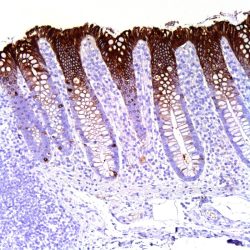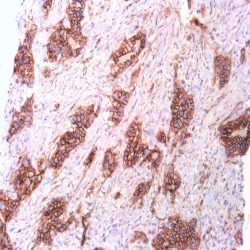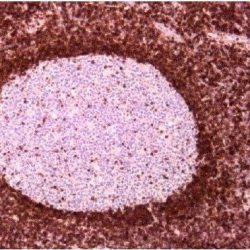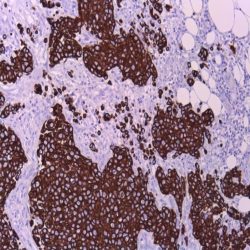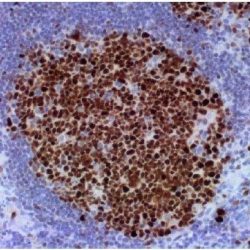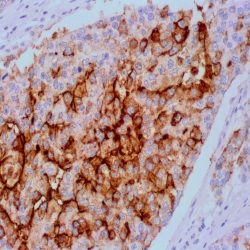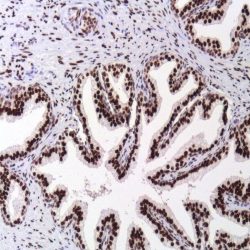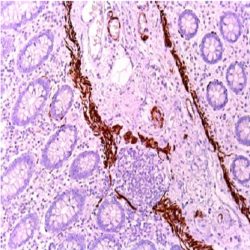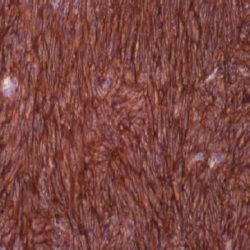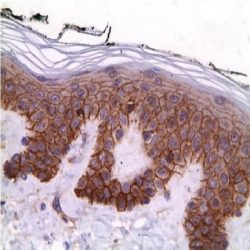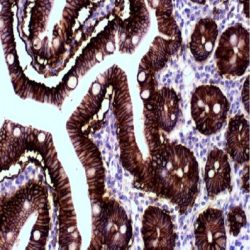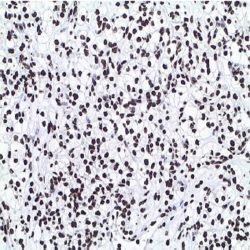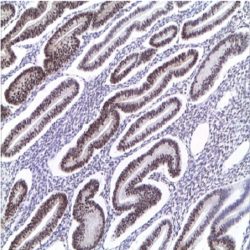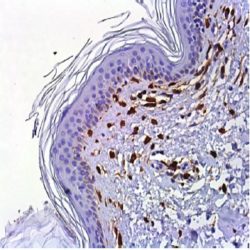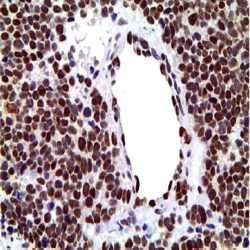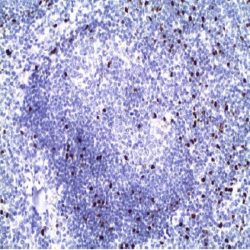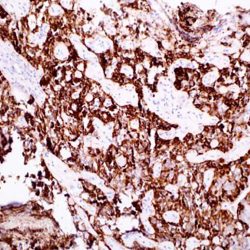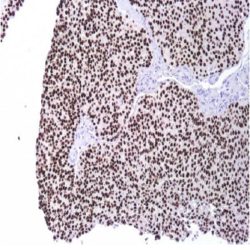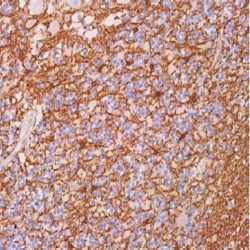دسته: مونوکلونال
نمایش 21–40 از 412 نتیجه
فیلتر ها-
آنتی بادیهای ایمونوهیستوشیمی
آنتی بادی Cytokeratin 20 (KS20.8)
نمره 0 از 5.Name: CytoKeratin 20 Antibody Clone Ks20.8
Description and aplications: Keratins (also known as cytokeratins) are intermediate filament/forming proteins that represents the main cytoskeleton of epithelial cells. They classically are classified based on Moll cataloging which grouped the basic-to-neutral type II keratins as K1–K8 and the acidic type I keratins as K9– K19. An updated classification including 24 types of keratins was then proposed in order to enable other mammalian species keratins to be added. Keratin 20 / cytokeratin20 (CK20) is a Type-I keratin which is primarily expressed in gastric and intestinal epithelium, urothelium, and Merkel-cells. CK20 is expressed in adenocarcinomas of the colon, stomach, pancreas and the bile system. CK20 is also present in mucinous ovarian tumors, transitional-cell and Merkel cell carcinomas. Notably, the squamous cell carcinomas and adenocarcinomas of the breast, lung, and endometrium, nonmucinous tumors of the ovary, and small cell carcinomas lack in CK20.
Composition: anti human keratin 20 mouse monoclonal antibody obtained from supernatant culture and prediluted in a Tris buffered solution pH 7.4 containing 0.375mM sodium azide solution as bacteriostatic and bactericidal.
Immunogen: semi-purified human cytokeratin preparation.
-
آنتی بادیهای ایمونوهیستوشیمی
آنتی بادی Beta Catenin-1 (EP35)
نمره 0 از 5Name: Beta-catenin Antibody Clone EP35
Description and applications: Beta-Catenin is a key regulatory protein involved in cell adhesion and signal transduction through the Wnt pathway, and plays important roles in development, cellular proliferation, and differentiation. Mutations in the Beta-Catenin gene CTNNB1 leading to stabilization of Beta-Catenin in the cytoplasm and translocation to the nucleus have been implicated in various forms of tumor including familial adenomatous polyposis, fibromatosis, solitary fibrous tumors and endometrial carcinoma. A nuclear accumulation of Beta-Catenin in fibromatosis (desmoid tumor) in various locations including breast and mesentery is useful in the differentiation of this tumor from other fibroblast like lesions.
Composition: anti-human Beta-catenin rabbit monoclonal antibody purified and prepared in 10mM PBS, pH 7.4, with 0.2% BSA and 0.09% sodium azide.
-
آنتی بادیهای ایمونوهیستوشیمی
آنتی بادی Bcl-2 (EP36)
نمره 0 از 5Name: Rabbit Anti-Human Bcl-2 Monoclonal Antibody Clone EP36
Description and applications: The Bcl-2 family of proteins regulates apoptosis by controlling mitochondrial permeability and release of cytochrome c. Bcl-2 is an anti-apoptotic protein that resides in the outer mitochondrial wall and inhibits release of cytochrome c. Over-expression of Bcl-2 has been shown to promote cell survival by suppressing apoptosis. It has been documented that bcl-2 becomes deregulated in tumor cells as a result of translocation into the immunoglobulin heavy-chain locus and is therefore activated in B cell malignancies. Bcl-2 antibody is useful in differentiation of follicular lymphoma from reactive follicular proliferation (bcl-2 negative). In addition, bcl-2 expression has been shown to be correlated with disease prognosis in breast cancer, prostate cancer, ovarian cancer, endometrial cancer and colon cancer. The sensitivity of this antibody in diagnosis of follicular lymphoma Nucleolar dot-like staining is frequently seen with this antibody and it should not interfere with the staining interpretation.
Composition: Antibody to Bcl-2 is affinity purified and diluted in 10 mM Phosphate buffered saline (PBS), pH 7.2 containing 1% bovine serum albumin (BSA) and 0.09% sodium azide (NaN3).
Immunogen: A synthetic peptide corresponding to residues between BH3 and BH4 of human Bcl-2 protein
-
آنتی بادیهای ایمونوهیستوشیمی
آنتی بادی Cytokeratin 19 (BA17)
نمره 0 از 5(Name: Mouse anti-human Cytokeratin 19 Monoclonal Antibody (Clone BA17
Description and Applications: Cytokeratin 19 is a member of type I acidic subfamily of intermediate filaments. It is expressed in variou different human tissues except in liver. Keratin 19 is not expressed in hepatocytes, therefore, antibody to keratin 19 is useful in the identification of liver metastasis. It is expressed by the great majority of breast carcinomas and used as a marker for sentinel lymph node evaluation both in frozen tissues and formalin fixed, paraffin embedded samples.
COMPOSITION: Anti-human Cytokeratin 19 mouse monoclonal antibody purified from serum and prepared in 10mM PBS, pH 7.4, with 0.2% BSA and 0.09% sodium azide.
IMMUNOGEN: Detergent soluble extract of human mammary epithelium.
-
آنتی بادیهای ایمونوهیستوشیمی
آنتی بادی Bcl-6 (LN22)
نمره 0 از 5.(Name: Mouse anti-human BCL-6 Monoclonal Antibody (Clone LN22
Description and applications: Bcl-6 proto-oncogene product (a Kruppel-type zinc-finger protein) is mainly expressed in normal germinal center B cells and related lymphomas. Bcl-6 is involved in chromosome rearrangements at 3q27 in non-Hodgkin’s lymphomas and Bcl-6 rearrangements have been detected in 33%-45% of diffuse large B cell lymphomas. Bcl-6 has been detected immunohistochemically in follicular lymphomas, diffuse large B cell lymphomas, Burkitt’s lymphomas and in nodular lymphocyte predominant Hodgkin lymphoma.
Composition: anti-human BCL-6 mouse monoclonal antibody purified from ascites. Prepared in 10mM PBS, pH 7.4, with 0.2% BSA and 0.09% sodium azide.
Immunogen: Recombinant BCL-6 protein.
-
آنتی بادیهای ایمونوهیستوشیمی
آنتی بادی BRST-3/TAG-72/CA72-4 (B72.3)
نمره 0 از 5(Name: Mouse anti-human BRST-3/TAG-72/CA72-4 Monoclonal Antibody (Clone B72.3
Description and applications: The Signet B72.3 monoclonal antibody recognizes TAG-72 (Tumor Associated Glycoprotein-72), a high molecular weight (220-400 kDa) glycoprotein complex.
In mature human tissue it does not produce positive reaction or if anything is very weak except for the secretory endometrium.
This antibody specifically recognizes the glycoprotein TAG-72, one oncofetal tumor-associated antigen expressed in a variety of human adenocarcinomas (84% of invasive ductal breast carcinomas, 85-90% of adenocarcinomas of the colon, pancreas, stomach , esophagus, lung, ovary and endometrium). It is not expressed in leukemias, lymphomas, sarcomas, mesotheliomas, melanomas or benign tumors.Composition: anti-human BRST-3rabbit monoclonal antibody purified from serum and prepared in 10mM PBS, pH 7.4, with 0.2% BSA and 0.09% sodium azide.
Immunogen: A membrane-enriched fraction of a breast carcinoma metastatic to the liver.
-
آنتی بادیهای ایمونوهیستوشیمی
آنتی بادی Androgen Receptor (SP107)
نمره 0 از 5.(Name: Mouse anti-human Androgen Receptor Monoclonal Antibody (Clone SP107
Description and applications: The expression of AR is reportedly inversely correlated with histologic grade i.e. well differentiated prostate tumors show higher expression than the poorly differentiated tumors. In prostate cancer, AR has been proposed as a marker of hormone-responsiveness. Composition: anti-human androgen receptor (AR) mouse monoclonal antibody purified from ascites. Prepared in 10mM PBS, pH 7.4, with 0.2% BSA and 0.09% sodium azide.
Immunogen: A synthetic peptide from human AR.
-
آنتی بادیهای ایمونوهیستوشیمی
آنتی بادی Desmin (D33)
نمره 0 از 5(Name: Mouse anti-human Desmin Monoclonal Antibody (Clone D33
Description and applications: Desmin is an intermediate filament protein of both smooth and striated muscles Antibody to desmin reacts with striated (skeletal and cardiac) as well as smooth muscle cells. In skeletal and cardiac muscles, the staining is confined to the Z-bands giving a characteristic striated appearance. Anti-desmin antibody is useful in identification of tumors of myogenic origin. It reacts with leiomyosarcomas (smooth muscle) as well as rhabdomyosarcomas (striated muscle). The antibody does not stain epithelial or myoepithelial cells, endometrial stromal tumors or ovarian cancer, lymphoid tissue, osteocytes, chondrocytes or mesothelial cells.
Composition: anti-human Desmin mouse monoclonal antibody purified from ascites. Prepared in 10mM PBS, pH 7.4, with 0.2% BSA and 0.09% sodium azide.
Immunogen: Desmin from human muscle.
-
آنتی بادیهای ایمونوهیستوشیمی
آنتی بادی DOG1 (Anoctamin-1) (SP31)
نمره 0 از 5.(Name: Rabbit anti-human DOG-1 Monoclonal Antibody (Clone SP31
Description and aplications: Dog1 is a cell surface protein of unknown function selectively expressed in gastrointestinal stromal tumors (GIST). Among GIST cases with KIT mutations the Dog1 antibody identified 11% more cases than c-Kit antibody . Dog1 identifies vast majority of both c-Kit negative and PDGFRA mutated GIST cases that may still benefit from imatinib mesylate (Gleevac), an inhibitor of the kit tyrosin kinase. In addition, Dog1 immunoreactivity is seen in fewer cases of mesenchymal, epithelial tumours and melanomas when compared with c-Kit. The use of this highly sensitive and specific novel marker will increase the accuracy of GIST diagnosis.
Composition: anti-human DOG1 rabbit monoclonal antibody purified from ascites. Prepared in 10mM PBS, pH 7.4, with 0.2% BSA and 0.09% sodium azide.
Immunogen: Synthetic peptide of human DOG-1 protein.
-
آنتی بادیهای ایمونوهیستوشیمی
آنتی بادی Epidermal Growth Factor Receptor (EP22)
نمره 0 از 5.(Name: EGFR (Epidermal growth factor receptor) Antibody (Clone EP22
Description and applications: The epidermal growth factor receptor (EGFR) is a transmembrane glycoprotein of 170 kDa with tyrosine-kinase activity after binding to the epidermal growth factor (EGF) and is involved in cell growth and differentiation. Tyrosine(Tyr) residues Tyr 1068, Tyr 1148 and Tyr 1173 located at the carboxy (C) terminal portion of the EGFR, are the places of autophosphorylation upon binding with the EGF. Determining the level of expression of EGFR is necessary to establish a specific treatment with monoclonal antibodies (cetuximab). The EGFR is overexpressed in some tumors of the colon, esophagus, stomach, breast, CNS, bladder, lung, head and neck, uterine cervix, vulva, ovary and endometrium. EGFR is expressed in a high percentage of metastases of squamous cell carcinomas of different locations and therefore its expression has been considered as an indicator of poor prognosis in these tumors. The antibody detects both EGFR phosphorylated on Tyr1068 of the mature human isoform 1 (corresponding to Y1092 from the precursor form P00533-1/p170), and also unphosphorylated EGFR.
Composition: anti-human EGFR rabbit monoclonal antibody purified by protein affinity and prepared in 10mM PBS, pH 7.4, with 0.2% BSA and 0.09% sodium azide.
Immunogen: A synthetic phoshopeptide corresponding to residues Tyr1068 of human EGFR was used as immunogen.
-
آنتی بادیهای ایمونوهیستوشیمی
آنتی بادی Epithelial Specific Antigen (BER-EP4)
نمره 0 از 5.(Name: Epithelial Specific Antigen (Clone Ber-EP4
Description and aplications: This antibody reacts with two glycoproteins of 34 and 49 kD molecular weight present on the surface and in the cytoplasm of all epithelial cells except the surface layer of the squamous epithelium, hepatocytes and parietal cells of the stomach. This antibody is specific to HEA125 equivalent. The antibody shows a broad pattern of reactivity with human epithelial tissues like simple epithelium, basal layer of the stratified squamous non-keratinized epithelia and epidermis. In contrast to other known anti-epithelial antibodies, this antibody does not mark the mesothelial cells and only a small number of mesotheliomas stained positively. This antibody does not react with nervous, glial, muscle, mesenchymal or lymphoid tissue. Due to the labile nature of the epitope in tissues fixed in buffered formalin and embedded in paraffin, negative staining results should be considered with caution.
Composition: anti-Ber-EP4 mouse monoclonal antibody obtained from supernatant culture and prediluted in a tris buffered solution pH 7.4 containing 0.375mM sodium azide solution as bacteriostatic and bactericidal.
Immunogen: MCF-7 human breast carcinoma cell line.
-
آنتی بادیهای ایمونوهیستوشیمی
آنتی بادی ERCC1 (SP68)
نمره 0 از 5.(Name: ERCC1 Antibody (Clone SP68
Description and applications: Nucleotide Excision Repair (NER) is a versatile mechanism capable of recognizing and eliminating damaged DNA, most commonly caused by UV radiations. ERCC1 is one of the three endonucleases that catalyzes this process. The ERCC1 gene is located on the chromosomal region 19q13.3-q13.2 and encodes a protein of 297 amino acids and about 32.5 kDa molecular weight. Although there are only few immunohistochemical studies with antibodies against ERCC1, it seems that tumors with extensive and intense immunohistochemical expression of this molecule have a worse prognosis and are resistant to platinum-based therapy. These tumors include non-small cell lung adenocarcinomas, gastrointestinal tract adenocarcinomas, breast, urinary bladder and adrenal cortex carcinomas, and advanced stage genital tract carcinomas.
Composition: anti-ERCC1 rabbit monoclonal antibody obtained from supernatant culture and prediluted in a tris buffered solution pH 7.4 containing 0.375mM sodium azide solution as bacteriostatic and bactericidal.
Immunogen: Recombinant human ERCC1 protein.
-
آنتی بادیهای ایمونوهیستوشیمی
آنتی بادی Estrogen Receptor (SP1)
نمره 0 از 5Name: Rabbit Anti-Human Estrogen Receptor (ER) Monoclonal Antibody clone SP1
Description and aplications: This rabbit monoclonal antibody (clone SP1) specifically reacts with the human alpha isoform of the estrogen receptors not having been tested in other species as mouse, rat and hamsters were it shows reactivity.This antibody is useful for immunohistochemical identification of estrogen receptor in normal and neoplastic cells estrogen dependent. However, the description of various types of benign and malignant neoplasms positive for estrogen receptors as meningiomas, lung and stomach adenocarcinoma, and above all in breast cancer, the amount of estrogen receptors expression in the tissue is an important parameter in predicting the prognosis of the disease and its response to endocrine therapy.
Presentation: ready-to-use
Composition: anti-ER rabbit monoclonal antibody obtained from supernatant culture and prediluted in a tris buffered solution pH 7.4 containing 0.375mM sodium azide solution as bacteriostatic and bactericidal.
Immunogen: Synthetic peptide derived from the C-terminus of human estrogen receptor alpha
Species reactivity: In vitro diagnostics in humans. Not tested in other species
-
آنتی بادیهای ایمونوهیستوشیمی
آنتی بادی Factor XIIIa (EP292)
نمره 0 از 5.(Name: Factor XIIIa (FXIIIa) Antibody (Clone EP292
Description and applications: Factor XIII (plasma transglutaminase, fibrin stabilizing factor) is a glycoprotein that circulates in blood as a tetramer, consisting of two A and two B subunits. Subunit A of factor XIII is an un-glycosylated 730-residue peptide with a molecular mass of 83 kD. It is the last enzyme generated in the blood coagulation cascade and is the zymogen for fibrinoligase, a transglutaminase that forms intramolecular gamma-glutamyl-epsilon-lysine crosslinking between fibrin molecules and thus stabilizes blood clots.
Factor XIII A is present in plasma, platelets, and monocytes, as well as macrophages and bone marrow precursors of these cell types and selective expression in subsets of stromal inflammatory cells. Factor XIII A is a marker for alternatively activated macrophages, while absence of Factor XIII A in monocyte-derived
macrophages is an indicator of their activated state. In addition, Factor XIII A is useful in distinguishing malignant fibrous histiocytoma (positive) from soft tissue tumor (negative).
Composition: anti-human FXIIIa rabbit monoclonal antibody purified from serum and prepared in 10mM PBS, pH 7.4, with 0.2% BSA and 0.09% sodium azide.
Immunogen: A synthetic peptide corresponding to residues of human Factor XIII A protein.
-
آنتی بادیهای ایمونوهیستوشیمی
آنتی بادی FLI1 (G146-222)
نمره 0 از 5Name: Fli-1 Antibody-Clone G146-222
Description and applications: The FLI-1 gene encodes the transcription factor of the same name (FLI-1 “Friend leukemia integration 1 transcription factor”) that has a fundamental role in embryonic development of blood vessels. Expression of Fli-1 appears as the first reliable marker of endothelial differentiation. In tumors such as Ewing sarcoma / primitive neuroectodermal tumor (ES / PNET), FLI-1 plays a pathogenic role and more than 90% of ES / PNET have the translocation t (11; 22) (q24, q12) producing the EWS fusion gene located on chromosome 22 with the Fli-1 gene located on chromosome 11. In other tumors, nuclear positivity for FLI-1 has been detected in 95% of benign (hemangiomas) and malignant (hemangioendothelioma, angiosarcoma, Kaposi’s sarcomas) vascular tumors, in different lymphomas, including lymphomas of precursor cells (lymphoblastic leukemia / lymphoblastic lymphoma), T cell lymphoma, of anaplastic large cell lymphomas, T angioinmmunoblastic lymphoma, enteropathy-associated T-cell lymphoma, all stages of mycosis fungoides with variable intensity and in 50% of peripheral T-cell lymphoma NOS. It was recently reported in melanomas.
Composition: anti-Fli1 mouse monoclonal antibody obtained from supernatant culture and prediluted in a tris buffered solution pH 7.4 containing 0.375mM sodium azide solution as bacteriostatic and bactericidal.
-
آنتی بادیهای ایمونوهیستوشیمی
آنتی بادی FOXP3 (SP97)
نمره 0 از 5.(Name: FoxP3 Antibody (Clone SP97
Description and aplications: FOX human protein family consists of at least 43 transcription factors, among which is the FoxP3 protein or Scurfin, whose gene is located on Xp11.23 chromosomal region. The proteins of this family are involved in a wide range of processes including control of cell proliferation and differentiation, immune regulation and signal transduction.. Foxp3 plays a very important role in the regulation of T cell activation and acts as transcriptional repressor transactivator suppressing cytokine genes by competition with the NF-AT / AP1 factor controlling the production of cytokines such as IL-2, IL-4, IFN-gamma, TNF-stimulating factor and granulocyte-macrophage colonies (GM-CSF). In addition to the important role that FOXP3 plays in regulating the immune response, recent studies have shown that this molecule can act as a tumor suppressor factor in intraepithelial neoplasia of the prostate, breast (especially in its triple negative variant) and ovarian among other. Generally, FOXP3 expression has dual character, meaning that usually some normal tissues with positive nuclear staining may develop negative tumors and, vice versa, when negative normal tissue occasionally produce positive tumors. This is the case for example of prostatic epithelium and mammary ducts where FOXP3 is expressed constitutively at nuclear level, or pancreatic ducts and melanocytes where staining is negative. In these tumors the presence of numerous positive cells is associated with a poorer response to chemotherapy.
Composition: anti-human FoxP3 rabbit monoclonal antibody purified by protein A/G in PBS/1% BSA buffer pH 7.6 with less than 0.1% sodium azide.
Immunogen: Synthetic peptide corresponding to C-terminus of human FoxP3.
-
آنتی بادیهای ایمونوهیستوشیمی
آنتی بادی FSH (Follicle Stimulating Hormone) (EP257)
نمره 0 از 5(Name: Rabbit anti-human FSH (Follicle Stimulating Hormone) Monoclonal Antibody (Clone EP257
Description and applications: The pituitary glycoprotein hormone family includes follicle-stimulating hormone, luteinizing hormone, chorionic gonadotropin, and thyroid-stimulating hormone. All of these glycoproteins consist of an identical alpha subunit and a hormone-specific beta subunit. FSH beta is the beta subunit of folliclestimulating hormone. In conjunction with luteinizing hormone, follicle-stimulating hormone induces egg and sperm production. The FSH antibody specifically labels Gonadotrophs in pituitatry. It may be useful in the classification of pituitary tumors.
Composition: Anti-human FSH (Follicle Stimulating Hormone) rabbit monoclonal antibody purified from . serum and prepared in 10mM PBS, pH 7.4, with 0.2% BSA and 0.09% sodium azide.
Immunogen: A synthetic peptide corresponding to residues of human FSH (beta subunit) protein.
-
آنتی بادیهای ایمونوهیستوشیمی
آنتی بادی Galectin-3 (B2C10)
نمره 0 از 5.(Name: Galectin 3 Antibody (Clone B2C10
Description and applications: The antibody recognizes a 30 kDa protein member of the family of the beta-galactosidase-binding lctin involved in cell growth, adhesion, inflammation and apoptosis processes. Galectin-3 is expressed in normal inflammatory cells (granulocytes) in vascular endothelium and in primary and metastatic malignancies of the colon, liver, breast, tongue and thyroid. This antibody is useful for differentiating between benign (adenomas) and thyroid malignancies. It may also be useful for the recognition of minimally invasive thyroid lesions. The combined use of Galectin-3 and HBME-1 may be helpful in the differential diagnosis between adenomas and oncocytic thyroid carcinomas. The sensitivity of galectin-3 to detect oncocytic carcinomas and the oncocytic variant of papillary carcinoma is 95%. The medullary carcinomas and normal thyroid follicles do not express galectin-3.
Composition: anti-Galectin 3 mouse monoclonal antibody obtained from supernatant culture and prediluted in a tris buffered solution pH 7.4 containing 0.375mM sodium azide solution as bacteriostatic and bactericidal.
Immunogen: Recombinant protein of the full length od the human Galectin-3 protein.
-
آنتی بادیهای ایمونوهیستوشیمی
آنتی بادی GATA-3 (L50-823)
نمره 0 از 5.(Name: GATA3 Antibody (Clone L50-823
Description and applications: GATA3 (GATA binding protein 3 to DNA sequence [A/T]GATA[A/G]) is a zinc finger transcription factor and plays an important role in promoting and directing cell proliferation, development, and differentiation in many tissues and cell types. GATA3 expression is primarily seen in breast carcinoma and urothelial carcinoma and only rarely found in tumors from other organs, such as endometrial endometrioid adenocarcinoma or yolk sac tumors. In the lymphoid system GATA-3 gene expression promotes receptor T cells and induces the activation of T helper type 2 cells. GATA3 is expressed in all breast lobular carcinomas and 91% of invasive ductal carcinomas (grade I, 100%; grade II, 89% and grade III, 86%1-2). GATA3 expression seems to be lower in luminal B subtype breast carcinoma. It has also been reported that GATA3 expression is correlated with the status of ER, PR and Her2 in breast carcinoma. GATA3 expression is found in urothelial carcinoma, especially in invasive and high grade tumors. Therefore, anti-GATA3 can be used in a panel of antibodies for diagnosis of unknown primary carcinoma, when carcinomas of the breast or bladder are a possibility. Isolated studies have demonstrated the usefulness of GATA-3, together with T-bet marker to differentiate between lymphocytic colitis and celiac disease. In germ cell tumors glandular areas of endodermal and trophoblastic differentiation might be stained. GATA 3 is also positive in many tissues such as parathyroid or salivary gland tumors; mucinous and non-mucinous pancreatic adenocarcinomas, squamous cell carcinomas, basal cell carcinomas, chromophobe carcinomas of the kidney, mesotheliomas, poorly differentiated papillary or mucinous adenocarcinomas of the lung, carcinomas of the stomach, colon, prostate, endometrium, thyroid, serous and Brenner benign and borderline ovarian tumors.
Composition: anti-human GATA3 mouse monoclonal antibody purified from ascites. Prepared in 10mM PBS, pH 7.4, with 0.2% BSA and 0.09% sodium azide.
-
آنتی بادیهای ایمونوهیستوشیمی
آنتی بادی GFAP (GA5)
نمره 0 از 5Name: Mouse anti-human Glial Fibrillary Acidic Protein (GFAP) Monoclonal Antibody
Description and applications: GFAP antibody stains astrocytes, glial cells, ependymal cells and their corresponding tumors. In the peripheral nervous system, Schwann cells, satellite cells, and enteric glial cells are stained. Weak staining of axons has been observed. Absorption studies show that this is caused by a cross-reaction with neurofilament protein. Ab-4 is particularly useful for distinguishing neoplasms of astrocytic origin from other neoplasms in the central nervous system by immunohistochemistry
Composition: anti-human GFAP rabbit polyclonal purified antibody fraction from rabbit anti-serum. Prepared in 10mM PBS, pH 7.4, with 0.2% BSA and 0.09% sodium azide.
Intended use : Immunohistochemistry (IHC) on paraffin embedded tissues. Not tested on frozen tissues or Western-Blotting
Immunogen: GFAP isolated from pig spinal cord
Species reactivity: In vitro diagnostics in humans. Not tested in other species

